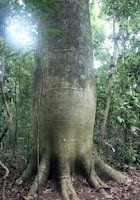The pucalupuna (Cavanillesia umbellata) is a very powerful plant. It is also called lupuna colorada, red lupuna — the word puca means red in Quechua — and must be distinguished from the white lupuna (Ceiba pentandra), also called lupuna blanca, lupuna, or kapok.
The pucalupuna wants to deal only with the strongest and most self-controlled of humans, those willing to undertake a dieta fuerte, a lengthy and rigorous diet in the jungle. Other humans it simply kills.
 |
| Pucalupuna (Cavanillesia umbellata) |
Indeed, the red lupuna is considered to be an evil tree. Its sap is considered poisonous. It is called lupuna bruja, sorcerer tree; there is even a verb, lupunear, which means to inflict magical harm with the lupuna. The base of the trunk is hollow and often looks swollen; hence the belief that the tree can cause a victim’s stomach to swell. It is believed to harm those who approach it without the proper protection; that is why poet César Calvo says that the spirit of the tree is so dangerous: ”If he finds you in his territory, he makes your belly swell, and you die with destroyed intestines.”
In fact, the trunk is essentially a giant hollow cylinder filled with a balsa-like pith; the tree also has a distinctive smooth reddish papery bark. The Shipibo say that the tree is hollow and contains fish, and that the water inside communicates with the underwater realms of the tsunki, the shamanically powerful dwellers in the rivers and lakes.
The evil nature of the pucalupuna affects everything it touches. One can, for example, harm an enemy simply by spreading the victim’s clothing around the base of the tree. One can put a bowl of tobacco juice in a hollow of the tree and leave it overnight, so the spirit of the tree allows its poisonous sap to run into the pot, turning it into a magical poison. One can also use the tree for countersorcery: take some skin from the heel of a sorcerer’s dead victim and bury it in a hole in the tree; the stomach of the unknown sorcerer will swell and burst.
The red lupuna can also grant the power of sorcery through contact. My teacher doña María Tuesta taught me how to make a packet of tobacco, place it into a cavity in the tree, and plug the hole with clay. Then, after eight days, she said, I should check the tobacco; it should now be full of worms. I should then put it back into the hole in the tree, plug it up again, and wait another eight days. Then I should remove the packet, mix it with water, and drink it, if I could; that would turn me into a powerful sorcerer.
It is because of its power that the tree is an ally of sorcerers, and that is precisely the reason why a healer should make the lupuna an ally as well, by ingesting it as part of la dieta in the jungle, by learning to call it for healing with its icaro, its magic song. The tree is used to inflict suffering; that makes it the best medicine for the suffering that others inflict.

- Previous Post: The Journals of Knud Rasmussen
- Next Post: Olivier Messiaen
- More Articles Related to: Plant Medicine, Shamanism, The Amazon



Thank you for this blog. My question is if you know of any icaros for the lupana or do you recommend to journey for one that will come to me.
I assume that you are asking about pucalupuna rather than the lupuna or kapok tree. Sadly, I cannot answer your question, for two reasons — first, because I am not even remotely qualified to do so; and, second, because I have no idea what your own personal relationship with the tree might be, or how the spirit of the tree might want, as part of that relationship, to give its songs to you. As a general rule for any plant — but I would think especially for such powerful plants as lupuna bruja — people should diet under the care and protection of an experienced and trustworthy teacher, who would know both your needs and capacities and the nature of the plant you are dieting with.
Hi Steve. I hope this finds you well. Can you tell us more about Ceiba pentandra uses in shamanism.